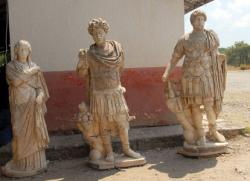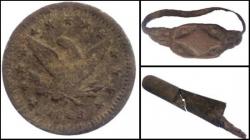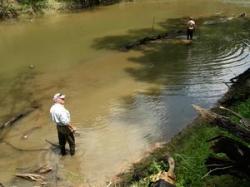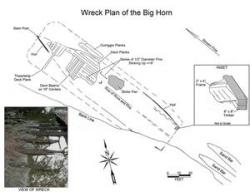- 20 - 21 AOÛT
- INDI-UNI : 
PRE-INSCRIPTION : 15 Juin – 31 Août
PRE-REGISTRATION: June 15th - August 31st
- CANADA – Trois Rivières - Il y a environ deux semaines, les archéologues ont trouvé un premier indice concret de l'emplacement de la palissade. En date d'hier, ils avaient repéré les traces de six pieux suivant un alignement et un espacement réguliers, pouvant coïncider avec les indices cartographiques disponibles. «Les empreintes circulaires ont 12 pouces de diamètre, ce qui correspond à ce qui était documenté pour les pieux de la palissade. Ces empreintes suivent un alignement et sont espacés d'environ 1,20 mètres chacun», détaille Mme Aubut-Robitaille. Les cavités circulaires révélées par les excavations archéologiques semblent avoir été remplies de roches et de terre lors de remblaiements postérieurs à la destruction de la palissade. Avec la collaboration d'un arpenteur, l'emplacement des pieux a été défini en plan. Puis, des coupes longitudinales et transversales des vestiges permettront de recueillir et d'interpréter beaucoup d'autres informations, selon Mme Aubut-Robitaille. «Ça va venir combler un vide. On pourra valider les hypothèses avec des données historiques», dit-elle. Comme le souligne l'historien trifluvien Yannick Gendron, c'est vers 1650 que Pierre Boucher, capitaine puis gouverneur, entreprit des travaux majeurs de fortification. «Il faut dire que la menace iroquoise pèse sur la population trifluvienne jusque vers 1665. Alors, la palissade est une question de survie. On va aux champs de jour, ce qui est en soit un acte de bravoure, et on rentre à l'intérieur la nuit», explique-t-il. «La palissade n'est pas statique. Elle est en constante évolution. Depuis le comptoir de traite de 1634 fondé par Théodore Bochart du Plessis jusqu'à la Conquête, elle est à géométrie variable», note encore l'historien, avant de citer Benjamin Sulte qui datait la construction de la palissade à 1653 («augmentée plus tard, reconstruite et changée plusieurs fois») et sa destruction à 1752. «Il reste beaucoup à faire pour bien connaître les ouvrages de défense trifluviens à l'époque de la Nouvelle-France. La découverte des vestiges est une contribution majeure à l'histoire de Trois-Rivières et un pas dans la bonne direction», conclut Yannick Gendron qui, comme Éléonore Aubut-Robitaille, suggère que le réaménagement de la place Pierre-Boucher et du Platon intègre la découverte de ces importants vestiges. Les aires de fouilles archéologiques sous la place Pierre-Boucher ont aussi dévoilé des objets dont la datation, après analyse, pourrait remonter à l'époque des premiers contacts entre les peuples autochtones et européens. La responsable du chantier, Éléonore Aubut-Robitaille, indique que des pipes de pierre dites Mic-Mac et un couteau pliant fait d'os se sont entre autres ajoutés aux objets déjà découverts sous la place Pierre-Boucher. «On a aussi trouvé des pièces de cuivre qui semblent avoir été découpées par les autochtones dans des casseroles européennes pour se faire des parures, et une perle taillée dans un tuyau de pipe en argile», ajoute Mme Aubut-Robitaille, en soulignant cette «appropriation par les amérindiens de la culture matérielle européenne».
http://www.cyberpresse.ca/le-nouvelliste/actualites/201108/05/01-4423615-des-vestiges-de-la-palissade-de-trois-rivieres-mis-au-jour.php
- VIET NAM –  Xuan Thien Ha - An inter-disciplinary team from different agencies in the central province of Thua Thien-Hue has begun to survey a shipwreck believed to date back to the early 19th century. The shipwreck is located two metres underwater and 100m off Xuan Thien Ha Beach in Phu Vang District's Vinh Xuan Commune. The 60m long, 10m wide steam-powered ship was discovered some 60-70 years ago and has been visited many times since by antique collectors and scrap merchants. Most of the ship is currently buried under sand. Tinh later submitted to the Department of Culture, Sports and Tourism a list of things he has found on the ship, including a set of elephant leg bones, a cast-iron torpedo, two ancient coins from the King Minh Mang era (1791-1841) and some porcelain ware. However, Vinh Xuan residents said scrap seekers have found other porcelain ware, a bronze pedestal for cannons, part of a steam engine and other metal equipment that have been sold or hidden in other places. Researcher Ho Tan Phan said the ship was a big and modern one in the first half of the 19th century. "It could be the ship that was presented by the French to the Nguyen dynasty (1802-1945) during the reign of King Tu Duc (1847-83) as mentioned in history books," he said.
Xuan Thien Ha - An inter-disciplinary team from different agencies in the central province of Thua Thien-Hue has begun to survey a shipwreck believed to date back to the early 19th century. The shipwreck is located two metres underwater and 100m off Xuan Thien Ha Beach in Phu Vang District's Vinh Xuan Commune. The 60m long, 10m wide steam-powered ship was discovered some 60-70 years ago and has been visited many times since by antique collectors and scrap merchants. Most of the ship is currently buried under sand. Tinh later submitted to the Department of Culture, Sports and Tourism a list of things he has found on the ship, including a set of elephant leg bones, a cast-iron torpedo, two ancient coins from the King Minh Mang era (1791-1841) and some porcelain ware. However, Vinh Xuan residents said scrap seekers have found other porcelain ware, a bronze pedestal for cannons, part of a steam engine and other metal equipment that have been sold or hidden in other places. Researcher Ho Tan Phan said the ship was a big and modern one in the first half of the 19th century. "It could be the ship that was presented by the French to the Nguyen dynasty (1802-1945) during the reign of King Tu Duc (1847-83) as mentioned in history books," he said.
http://vietnamnews.vnagency.com.vn/Life-Style/214554/Divers-examine-19th-century-shipwreck.html
- TURQUIE –  – Tlos - New excavation work in the ancient city of Tlos in Muğla’s Fethiye district has unearthed several ancient sculptures of Roman emperors. The archaeological team found sculptures of Roman emperors Hadrian; Antonius Pius and his daughter Faistinaminor; Mareus Aurellus as well as the Goddess Issis, according to Taner Korkut, who is leading the dig. The excavation, which is being conducted with a 40-person team and 36 workers, has unearthed traces of sculptures and archaeological artifacts dating back 10,500 years. Noting that the team made carbon tests on the newly found remains, Korkut said: “A few years before, we discovered archaeological discoveries which dated back 2,700 years. However, the last discoveries are from 10,500 years ago. Those remains also give information about the people’s lives in the ancient era.” Tlos was formerly a center of Lycian civilization, Korkut said.
– Tlos - New excavation work in the ancient city of Tlos in Muğla’s Fethiye district has unearthed several ancient sculptures of Roman emperors. The archaeological team found sculptures of Roman emperors Hadrian; Antonius Pius and his daughter Faistinaminor; Mareus Aurellus as well as the Goddess Issis, according to Taner Korkut, who is leading the dig. The excavation, which is being conducted with a 40-person team and 36 workers, has unearthed traces of sculptures and archaeological artifacts dating back 10,500 years. Noting that the team made carbon tests on the newly found remains, Korkut said: “A few years before, we discovered archaeological discoveries which dated back 2,700 years. However, the last discoveries are from 10,500 years ago. Those remains also give information about the people’s lives in the ancient era.” Tlos was formerly a center of Lycian civilization, Korkut said.
http://www.hurriyetdailynews.com/n.php?n=excavations-at-tlos-reveal-roman-works-2011-08-18
- SUEDE – Oland - The wreck of a Swedish warship that historians hope is the Mars, head of king Erik XIV’s fleet before it sank in the Baltic in 1564, has been found off Sweden’s coast, museum officials said on Friday. A team of divers discovered the wreck at a depth of 75 metres (250 feet), 10 nautical miles (18.5 kilometres) north of the Swedish island of Oland, Stockholm’s maritime history museum said in a statement. The find came after several years of research. “Everything suggests that it is indeed the Mars that we have found,” Richard Lundgren, one of the divers, said in the statement. “The size and the age of the ship correspond,” with historical records, he added. A stack of corn, the symbol of the Swedish royal family at the time, was found engraved on a cannon, providing another strong clue. Equipped with 107 cannons and a crew of 800, the Mars was one of the biggest ships of its day. Just a year after being launched it was sunk in May 1564 during a major battle against the Danish fleet. More than 450 years later, the experts think the Mars has reappeared and “it seems to be well preserved,” though with a hole in its side, Olsson told reporters.
http://www.dawn.com/2011/08/20/wreck-of-16th-century-swedish-warship-found-in-baltic.html
- USA –  Camp Lawton - A Civil War prison in Georgia -- briefly the largest prison camp of the conflict -- continues to provide archaeologists with fresh artifacts, including the personal belongings of Union soldiers held there. Camp Lawton, in Millen, Ga., has been the site of an excavation by a team from Georgia Southern University since last year. This week, university officials announced the team had found a ring, a corps badge, keys to furniture and doors, suspender buckles and a pocket knife. Camp Lawton was built by the Confederacy to replace Andersonville, where about a quarter of the 45,000 Union prisoners held captive are believed to have died of malnutrition and disease. More than 10,000 Union prisoners were housed at the camp, which opened near the end of the Civil War and was only briefly in operation.
Camp Lawton - A Civil War prison in Georgia -- briefly the largest prison camp of the conflict -- continues to provide archaeologists with fresh artifacts, including the personal belongings of Union soldiers held there. Camp Lawton, in Millen, Ga., has been the site of an excavation by a team from Georgia Southern University since last year. This week, university officials announced the team had found a ring, a corps badge, keys to furniture and doors, suspender buckles and a pocket knife. Camp Lawton was built by the Confederacy to replace Andersonville, where about a quarter of the 45,000 Union prisoners held captive are believed to have died of malnutrition and disease. More than 10,000 Union prisoners were housed at the camp, which opened near the end of the Civil War and was only briefly in operation.
http://www.latimes.com/news/nationworld/nation/la-naw-civil-war-prison-20110820,0,269087.story
- USA – 
 Morehouse - A large steamboat that burned and sank in Morehouse Parish over a century ago has been recorded as an archaeological site with the state of Louisiana. For decades the subject of local legends, the sunken boat is now designated as “Big Horn Steamboat Wreck,” Archaeological Site No. 16MO185. Field notes and subsequent historical research are included in the site record, which states the boat may have research potential as an example of a vessel that “was part of riverine commerce and transportation before the advent of railroads.” The site narrative and Saltus’ field observations shed light on the mysterious boat. Saltus measured the wreck’s size at approximately 141 by 32 feet and he was able to determine it had been a sternwheel, rather than sidewheel, steamboat. “It is also evident that portions of the vessel’s remains showed signs of scorching from a fire ... Through a process of elimination, Saltus determined that the Big Horn was the best fit for the archival and field data on hand.” The Big Horn was a 312-ton sternwheeler built in New Albany, Ind. in 1865 and measured 152 by 32 feet. She sank in Bayou Bartholomew on April 10, 1873 after her cargo of lime caught fire. The report explains, “Lime was then generally carried in wooden barrels and if wetted will generate heat. It is possible that the cargo was wetted and the heat ignited the barrels and led to the Big Horn’s fire.”
Morehouse - A large steamboat that burned and sank in Morehouse Parish over a century ago has been recorded as an archaeological site with the state of Louisiana. For decades the subject of local legends, the sunken boat is now designated as “Big Horn Steamboat Wreck,” Archaeological Site No. 16MO185. Field notes and subsequent historical research are included in the site record, which states the boat may have research potential as an example of a vessel that “was part of riverine commerce and transportation before the advent of railroads.” The site narrative and Saltus’ field observations shed light on the mysterious boat. Saltus measured the wreck’s size at approximately 141 by 32 feet and he was able to determine it had been a sternwheel, rather than sidewheel, steamboat. “It is also evident that portions of the vessel’s remains showed signs of scorching from a fire ... Through a process of elimination, Saltus determined that the Big Horn was the best fit for the archival and field data on hand.” The Big Horn was a 312-ton sternwheeler built in New Albany, Ind. in 1865 and measured 152 by 32 feet. She sank in Bayou Bartholomew on April 10, 1873 after her cargo of lime caught fire. The report explains, “Lime was then generally carried in wooden barrels and if wetted will generate heat. It is possible that the cargo was wetted and the heat ignited the barrels and led to the Big Horn’s fire.”
http://www.bastropenterprise.com/features/x27460332/Local-shipwreck-now-eligible-for-National-Register